flat tire MAZDA MODEL 3 HATCHBACK 2006 (in English) Owner's Guide
[x] Cancel search | Manufacturer: MAZDA, Model Year: 2006, Model line: MODEL 3 HATCHBACK, Model: MAZDA MODEL 3 HATCHBACK 2006Pages: 372, PDF Size: 5.55 MB
Page 259 of 372
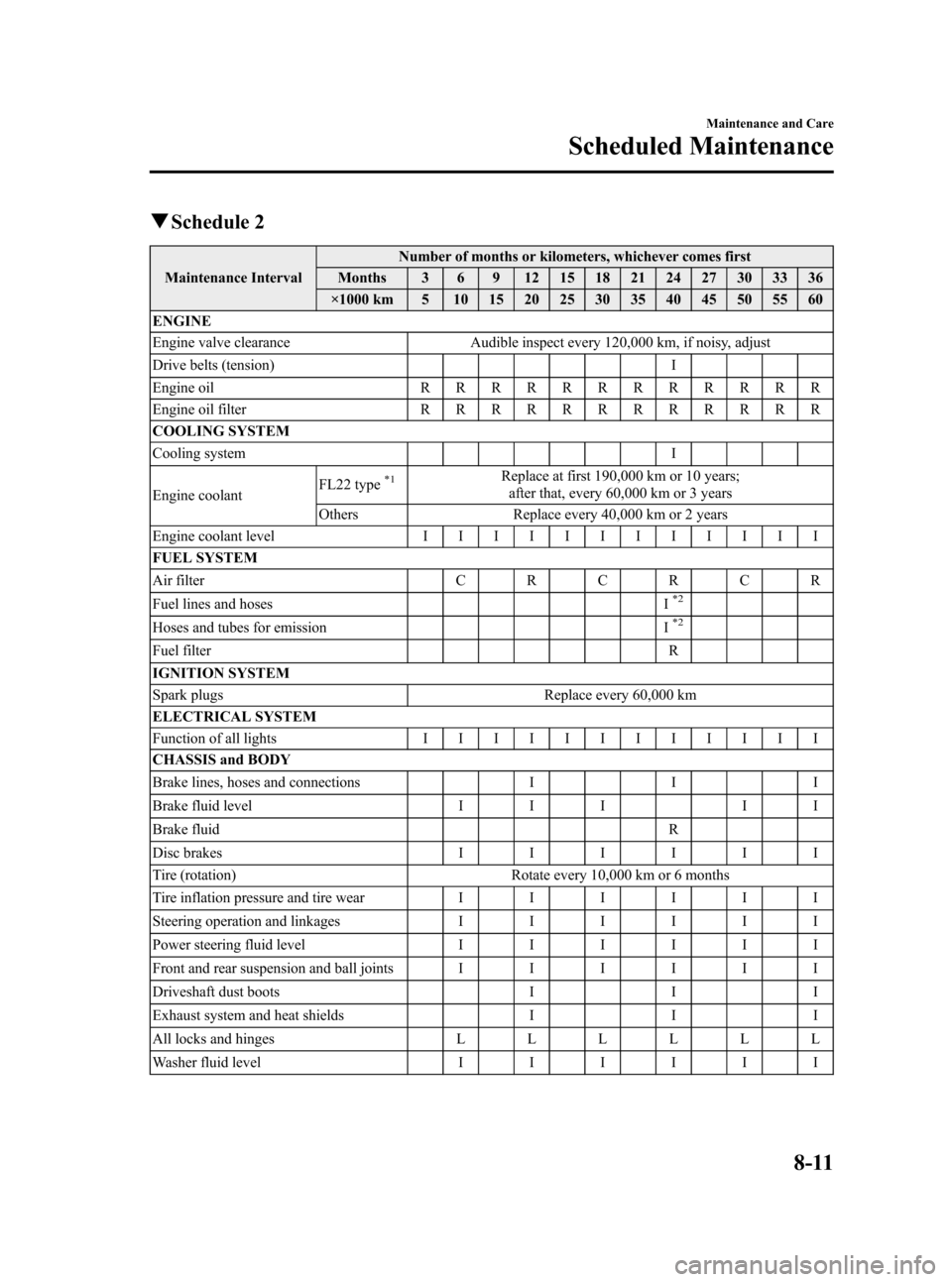
Black plate (259,1)
qSchedule 2
Maintenance IntervalNumber of months or kilometers, whichever comes first
Months 3 6 9 12 15 18 21 24 27 30 33 36
×1000 km 5 10 15 20 25 30 35 40 45 50 55 60
ENGINE
Engine valve clearance Audible inspect every 120,000 km, if noisy, adjust
Drive belts (tension) I
Engine oil RRRRRRRRRRRR
Engine oil filter RRRRRRRRRRRR
COOLING SYSTEM
Cooling system I
Engine coolantFL22 type
*1Replace at first 190,000 km or 10 years;
after that, every 60,000 km or 3 years
Others Replace every 40,000 km or 2 years
Engine coolant level I IIIIIIIIIII
FUEL SYSTEM
Air filterCRCRCR
Fuel lines and hoses I
*2
Hoses and tubes for emission I*2
Fuel filter R
IGNITION SYSTEM
Spark plugs Replace every 60,000 km
ELECTRICAL SYSTEM
Function of all lights I IIIIIIIIIII
CHASSIS and BODY
Brake lines, hoses and connections I I I
Brake fluid level I I I I I
Brake fluid R
Disc brakes I I I I I I
Tire (rotation) Rotate every 10,000 km or 6 months
Tire inflation pressure and tire wear I I I I I I
Steering operation and linkages I I I I I I
Power steering fluid level I I I I I I
Front and rear suspension and ball joints I I I I I I
Driveshaft dust boots I I I
Exhaust system and heat shields I I I
All locks and hinges L L L L L L
Washer fluid level I I I I I I
Maintenance and Care
Scheduled Maintenance
8-11
Mazda3_8U55-EA-05G_Edition2 Page259
Thursday, June 23 2005 2:56 PM
Form No.8U55-EA-05G
Page 261 of 372
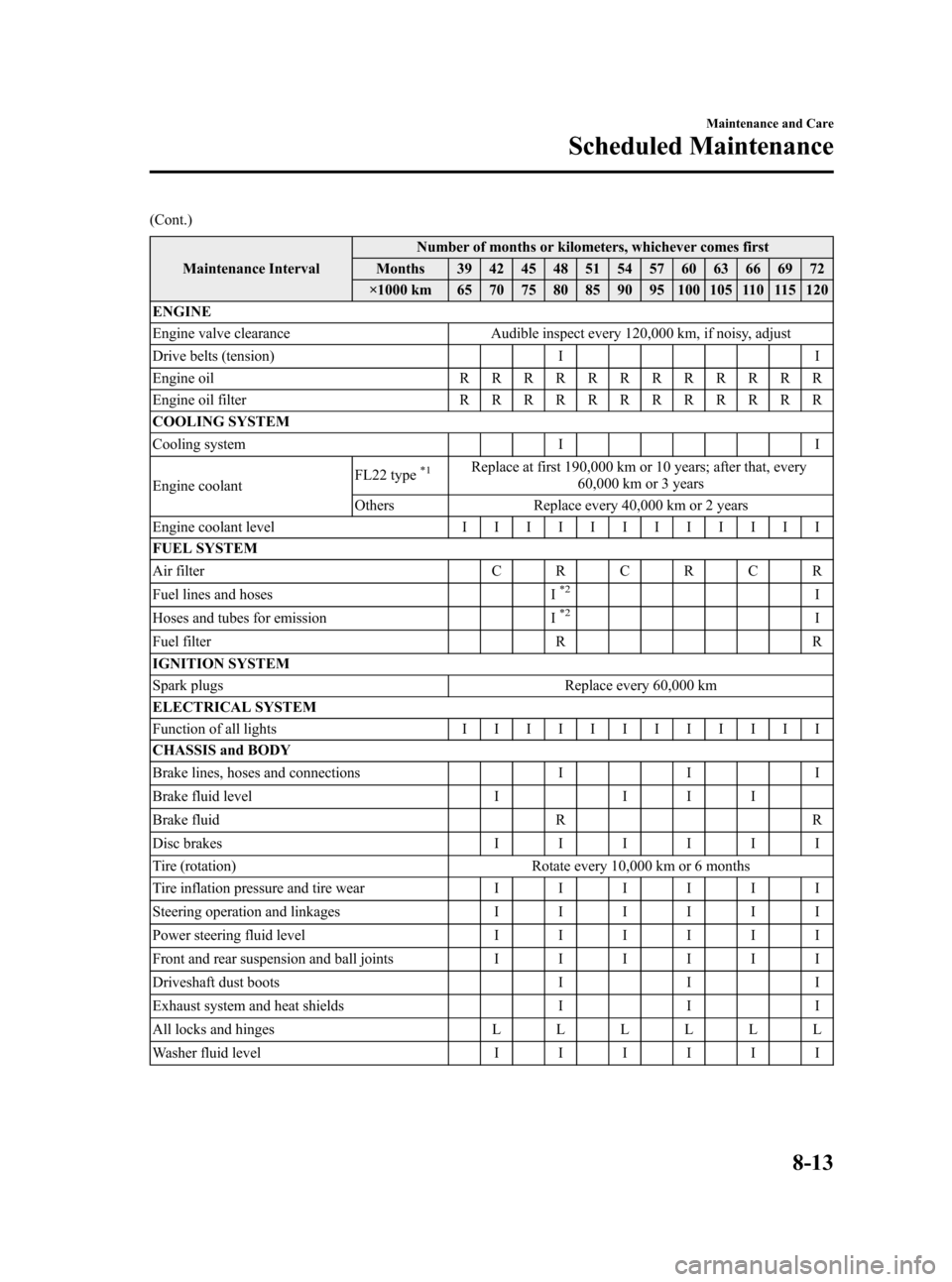
Black plate (261,1)
(Cont.)
Maintenance IntervalNumber of months or kilometers, whichever comes first
Months 39 42 45 48 51 54 57 60 63 66 69 72
×1000 km 65 70 75 80 85 90 95 100 105 110 115 120
ENGINE
Engine valve clearance Audible inspect every 120,000 km, if noisy, adjust
Drive belts (tension) I I
Engine oilRRRRRRRRRRRR
Engine oil filterRRRRRRRRRRRR
COOLING SYSTEM
Cooling system I I
Engine coolantFL22 type
*1Replace at first 190,000 km or 10 years; after that, every
60,000 km or 3 years
Others Replace every 40,000 km or 2 years
Engine coolant levelIIIIIIIIIIII
FUEL SYSTEM
Air filterCRCRCR
Fuel lines and hoses I
*2I
Hoses and tubes for emission I*2I
Fuel filter R R
IGNITION SYSTEM
Spark plugs Replace every 60,000 km
ELECTRICAL SYSTEM
Function of all lightsIIIIIIIIIIII
CHASSIS and BODY
Brake lines, hoses and connections I I I
Brake fluid level I I I I
Brake fluid R R
Disc brakesIIIIII
Tire (rotation) Rotate every 10,000 km or 6 months
Tire inflation pressure and tire wearIIIIII
Steering operation and linkagesIIIIII
Power steering fluid levelIIIIII
Front and rear suspension and ball jointsIIIIII
Driveshaft dust boots I I I
Exhaust system and heat shields I I I
All locks and hingesLLLLLL
Washer fluid levelIIIIII
Maintenance and Care
Scheduled Maintenance
8-13
Mazda3_8U55-EA-05G_Edition2 Page261
Thursday, June 23 2005 2:56 PM
Form No.8U55-EA-05G
Page 263 of 372
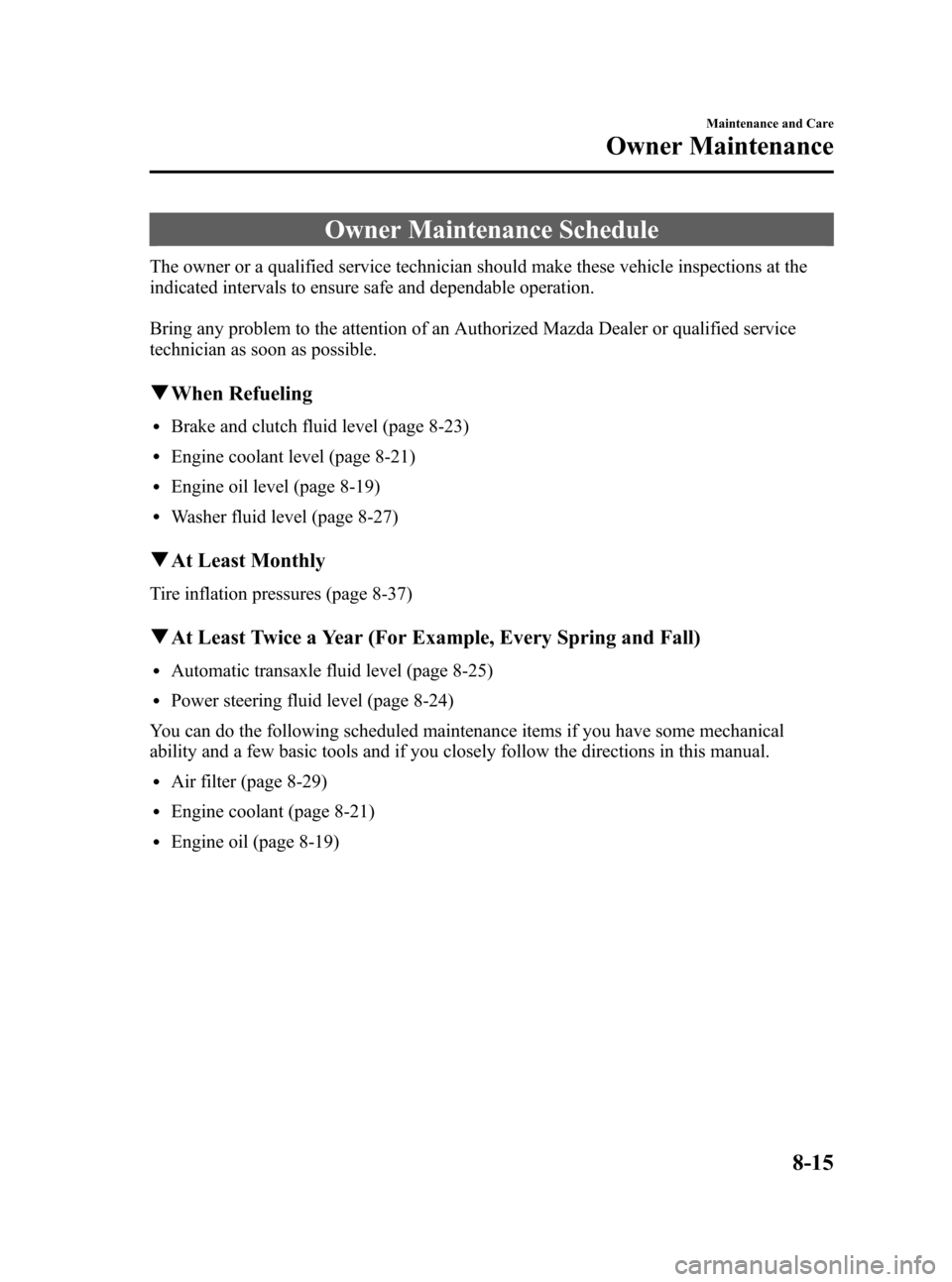
Black plate (263,1)
Owner Maintenance Schedule
The owner or a qualified service technician should make these vehicle inspections at the
indicated intervals to ensure safe and dependable operation.
Bring any problem to the attention of an Authorized Mazda Dealer or qualified service
technician as soon as possible.
qWhen Refueling
lBrake and clutch fluid level (page 8-23)
lEngine coolant level (page 8-21)
lEngine oil level (page 8-19)
lWasher fluid level (page 8-27)
qAt Least Monthly
Tire inflation pressures (page 8-37)
qAt Least Twice a Year (For Example, Every Spring and Fall)
lAutomatic transaxle fluid level (page 8-25)
lPower steering fluid level (page 8-24)
You can do the following scheduled maintenance items if you have some mechanical
ability and a few basic tools and if you closely follow the directions in this manual.
lAir filter (page 8-29)
lEngine coolant (page 8-21)
lEngine oil (page 8-19)
Maintenance and Care
Owner Maintenance
8-15
Mazda3_8U55-EA-05G_Edition2 Page263
Thursday, June 23 2005 2:56 PM
Form No.8U55-EA-05G
Page 285 of 372
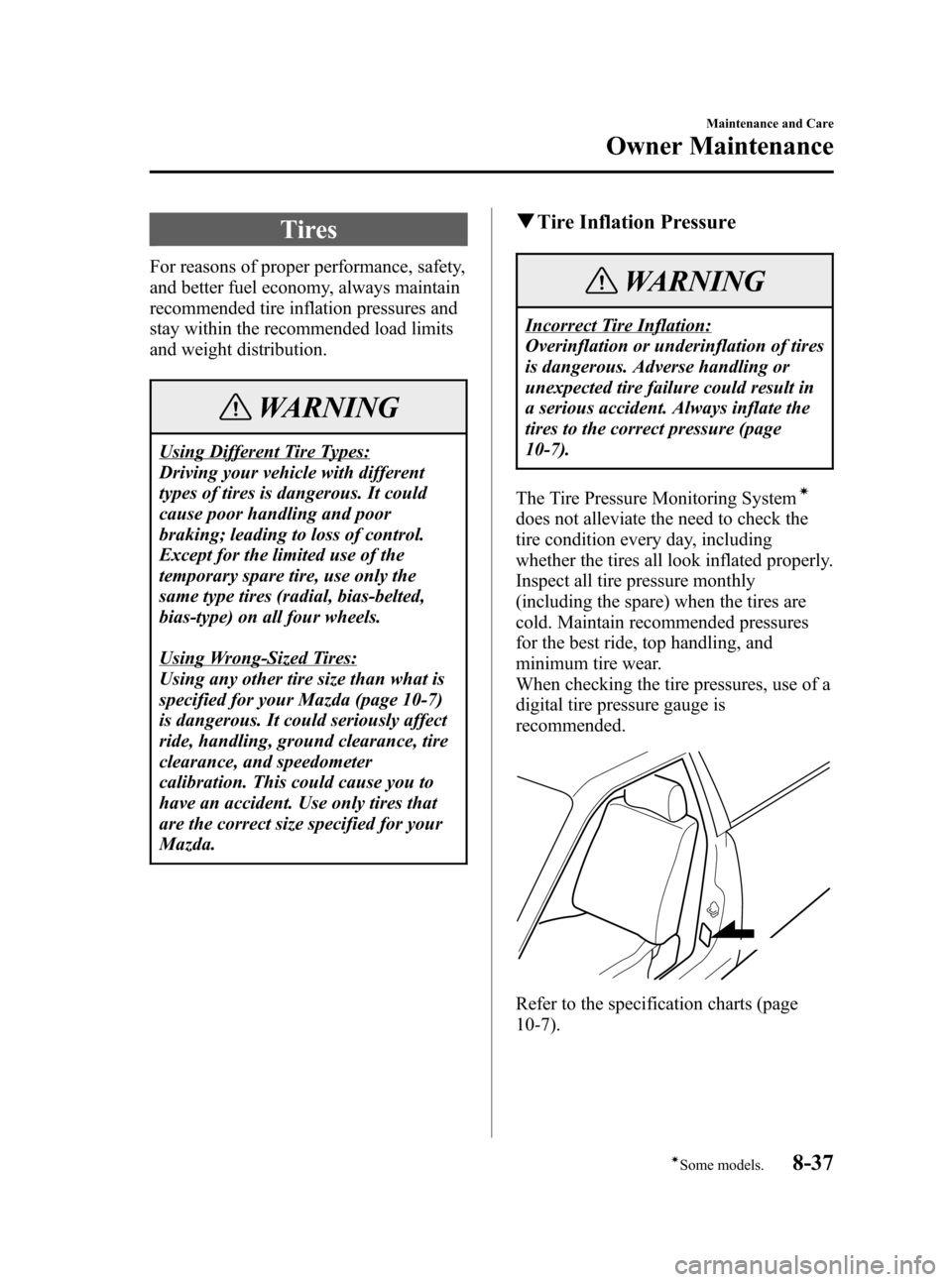
Black plate (285,1)
Tires
For reasons of proper performance, safety,
and better fuel economy, always maintain
recommended tire inflation pressures and
stay within the recommended load limits
and weight distribution.
WARNING
Using Different Tire Types:
Driving your vehicle with different
types of tires is dangerous. It could
cause poor handling and poor
braking; leading to loss of control.
Except for the limited use of the
temporary spare tire, use only the
same type tires (radial, bias-belted,
bias-type) on all four wheels.
Using Wrong-Sized Tires:
Using any other tire size than what is
specified for your Mazda (page 10-7)
is dangerous. It could seriously affect
ride, handling, ground clearance, tire
clearance, and speedometer
calibration. This could cause you to
have an accident. Use only tires that
are the correct size specified for your
Mazda.
qTire Inflation Pressure
WARNING
Incorrect Tire Inflation:
Overinflation or underinflation of tires
is dangerous. Adverse handling or
unexpected tire failure could result in
a serious accident. Always inflate the
tires to the correct pressure (page
10-7).
The Tire Pressure Monitoring System
í
does not alleviate the need to check the
tire condition every day, including
whether the tires all look inflated properly.
Inspect all tire pressure monthly
(including the spare) when the tires are
cold. Maintain recommended pressures
for the best ride, top handling, and
minimum tire wear.
When checking the tire pressures, use of a
digital tire pressure gauge is
recommended.
Refer to the specification charts (page
10-7).
Maintenance and Care
Owner Maintenance
8-37íSome models. Mazda3_8U55-EA-05G_Edition2 Page285
Thursday, June 23 2005 2:56 PM
Form No.8U55-EA-05G
Page 286 of 372
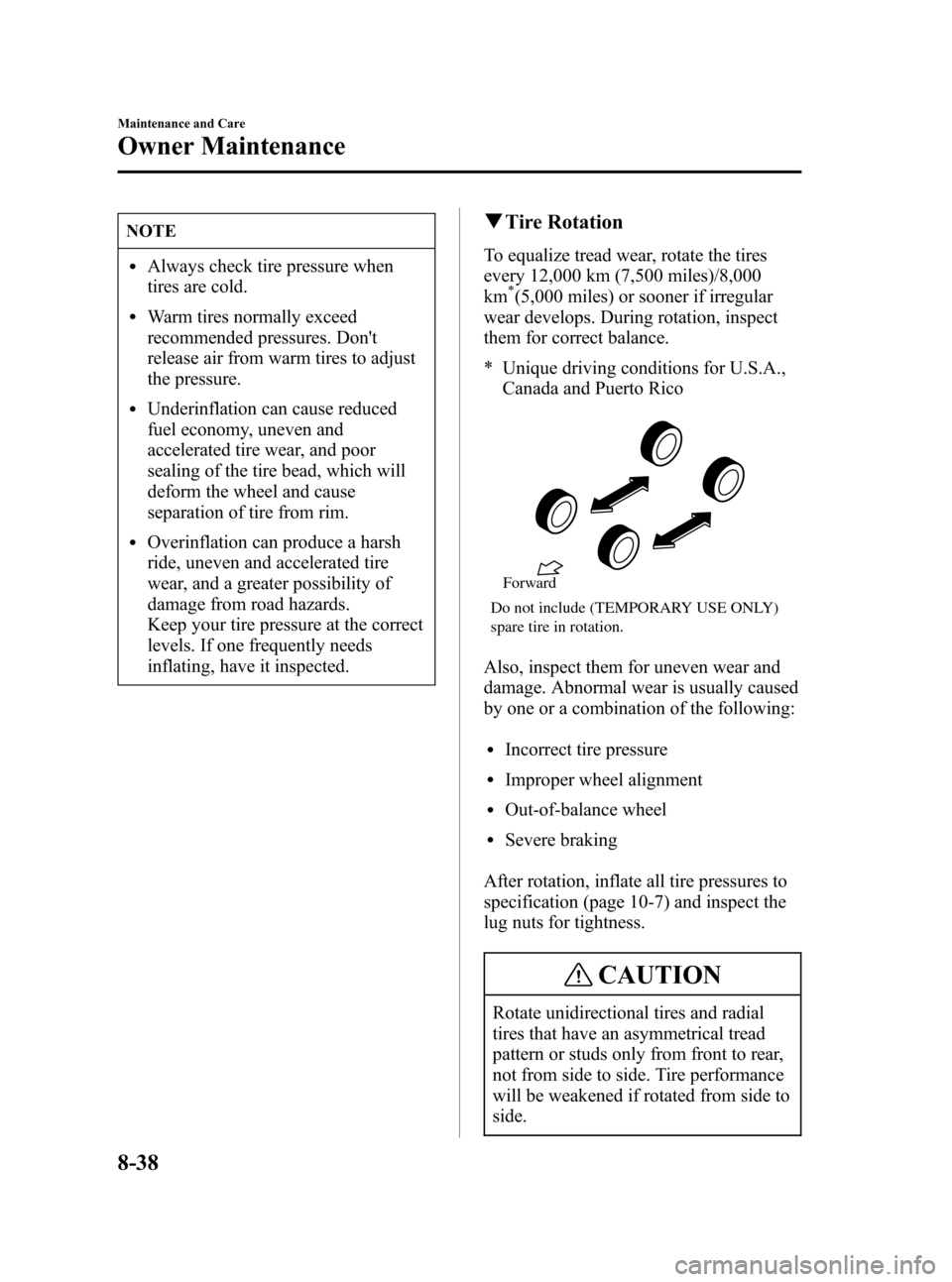
Black plate (286,1)
NOTE
lAlways check tire pressure when
tires are cold.
lWarm tires normally exceed
recommended pressures. Don't
release air from warm tires to adjust
the pressure.
lUnderinflation can cause reduced
fuel economy, uneven and
accelerated tire wear, and poor
sealing of the tire bead, which will
deform the wheel and cause
separation of tire from rim.
lOverinflation can produce a harsh
ride, uneven and accelerated tire
wear, and a greater possibility of
damage from road hazards.
Keep your tire pressure at the correct
levels. If one frequently needs
inflating, have it inspected.
qTire Rotation
To equalize tread wear, rotate the tires
every 12,000 km (7,500 miles)/8,000
km
*(5,000 miles) or sooner if irregular
wear develops. During rotation, inspect
them for correct balance.
* Unique driving conditions for U.S.A.,
Canada and Puerto Rico
Do not include (TEMPORARY USE ONLY)
spare tire in rotation.Forward
Also, inspect them for uneven wear and
damage. Abnormal wear is usually caused
by one or a combination of the following:
lIncorrect tire pressure
lImproper wheel alignment
lOut-of-balance wheel
lSevere braking
After rotation, inflate all tire pressures to
specification (page 10-7) and inspect the
lug nuts for tightness.
CAUTION
Rotate unidirectional tires and radial
tires that have an asymmetrical tread
pattern or studs only from front to rear,
not from side to side. Tire performance
will be weakened if rotated from side to
side.
8-38
Maintenance and Care
Owner Maintenance
Mazda3_8U55-EA-05G_Edition2 Page286
Thursday, June 23 2005 2:56 PM
Form No.8U55-EA-05G
Page 288 of 372
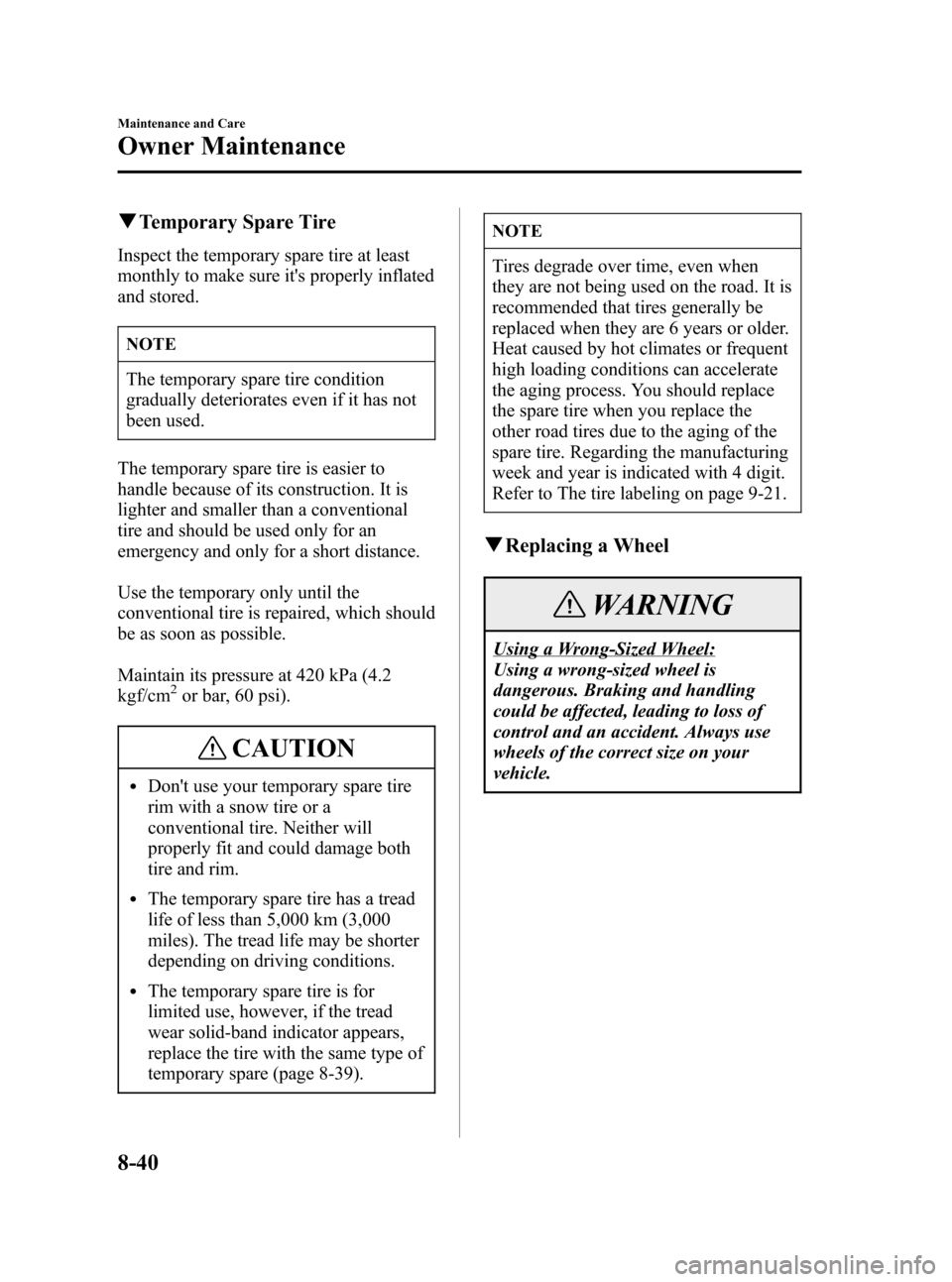
Black plate (288,1)
qTemporary Spare Tire
Inspect the temporary spare tire at least
monthly to make sure it's properly inflated
and stored.
NOTE
The temporary spare tire condition
gradually deteriorates even if it has not
been used.
The temporary spare tire is easier to
handle because of its construction. It is
lighter and smaller than a conventional
tire and should be used only for an
emergency and only for a short distance.
Use the temporary only until the
conventional tire is repaired, which should
be as soon as possible.
Maintain its pressure at 420 kPa (4.2
kgf/cm
2or bar, 60 psi).
CAUTION
lDon't use your temporary spare tire
rim with a snow tire or a
conventional tire. Neither will
properly fit and could damage both
tire and rim.
lThe temporary spare tire has a tread
life of less than 5,000 km (3,000
miles). The tread life may be shorter
depending on driving conditions.
lThe temporary spare tire is for
limited use, however, if the tread
wear solid-band indicator appears,
replace the tire with the same type of
temporary spare (page 8-39).
NOTE
Tires degrade over time, even when
they are not being used on the road. It is
recommended that tires generally be
replaced when they are 6 years or older.
Heat caused by hot climates or frequent
high loading conditions can accelerate
the aging process. You should replace
the spare tire when you replace the
other road tires due to the aging of the
spare tire. Regarding the manufacturing
week and year is indicated with 4 digit.
Refer to The tire labeling on page 9-21.
qReplacing a Wheel
WARNING
Using a Wrong-Sized Wheel:
Using a wrong-sized wheel is
dangerous. Braking and handling
could be affected, leading to loss of
control and an accident. Always use
wheels of the correct size on your
vehicle.
8-40
Maintenance and Care
Owner Maintenance
Mazda3_8U55-EA-05G_Edition2 Page288
Thursday, June 23 2005 2:56 PM
Form No.8U55-EA-05G
Page 289 of 372
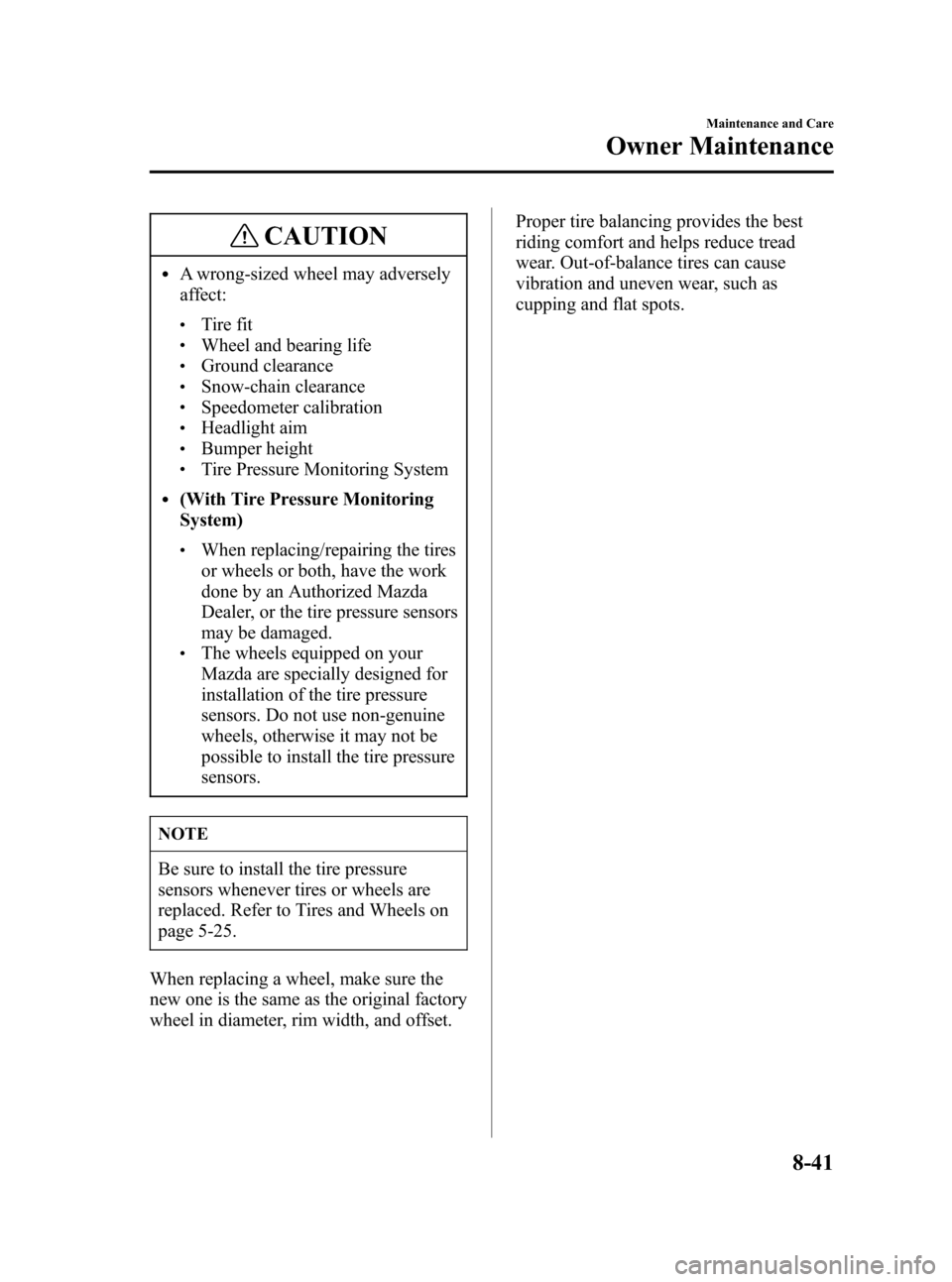
Black plate (289,1)
CAUTION
lA wrong-sized wheel may adversely
affect:
lTire fitlWheel and bearing lifelGround clearancelSnow-chain clearancelSpeedometer calibrationlHeadlight aimlBumper heightlTire Pressure Monitoring System
l(With Tire Pressure Monitoring
System)
lWhen replacing/repairing the tires
or wheels or both, have the work
done by an Authorized Mazda
Dealer, or the tire pressure sensors
may be damaged.
lThe wheels equipped on your
Mazda are specially designed for
installation of the tire pressure
sensors. Do not use non-genuine
wheels, otherwise it may not be
possible to install the tire pressure
sensors.
NOTE
Be sure to install the tire pressure
sensors whenever tires or wheels are
replaced. Refer to Tires and Wheels on
page 5-25.
When replacing a wheel, make sure the
new one is the same as the original factory
wheel in diameter, rim width, and offset.Proper tire balancing provides the best
riding comfort and helps reduce tread
wear. Out-of-balance tires can cause
vibration and uneven wear, such as
cupping and flat spots.
Maintenance and Care
Owner Maintenance
8-41
Mazda3_8U55-EA-05G_Edition2 Page289
Thursday, June 23 2005 2:56 PM
Form No.8U55-EA-05G
Page 334 of 372

Black plate (334,1)
WARNING
The temperature grade for this tire is established for a tire that is properly inflated and
not overloaded. Excessive speed, underinflation, or excessive loading, either
separately or in combination, can cause heat buildup and possible tire failure.
These grades will be added to the sidewalls of passenger vehicle tires over the next several
years according to a schedule established by the NHTSA and the tire manufacturers.
The grade of tires available as standard or optional equipment on Mazda vehicles may vary
with respect to grade.
ALL PASSENGER VEHICLE TIRES MUST CONFORM TO THESE GRADES AND
TO ALL OTHER FEDERAL TIRE-SAFETY REQUIREMENTS.
qUniform Tire Quality Grading
Quality grades can be found where applicable on the tire sidewall between tread shoulder
and maximum section width.
For example:
Treadwear 200 Traction AA Temperature A
TREADWEAR 200 TRACTION AA
TEMPERATURE A
UTQGS MARK (example)
9-20
Customer Information and Reporting Safety Defects
Uniform Tire Quality Grading System (UTQGS)
Mazda3_8U55-EA-05G_Edition2 Page334
Thursday, June 23 2005 2:56 PM
Form No.8U55-EA-05G
Page 336 of 372
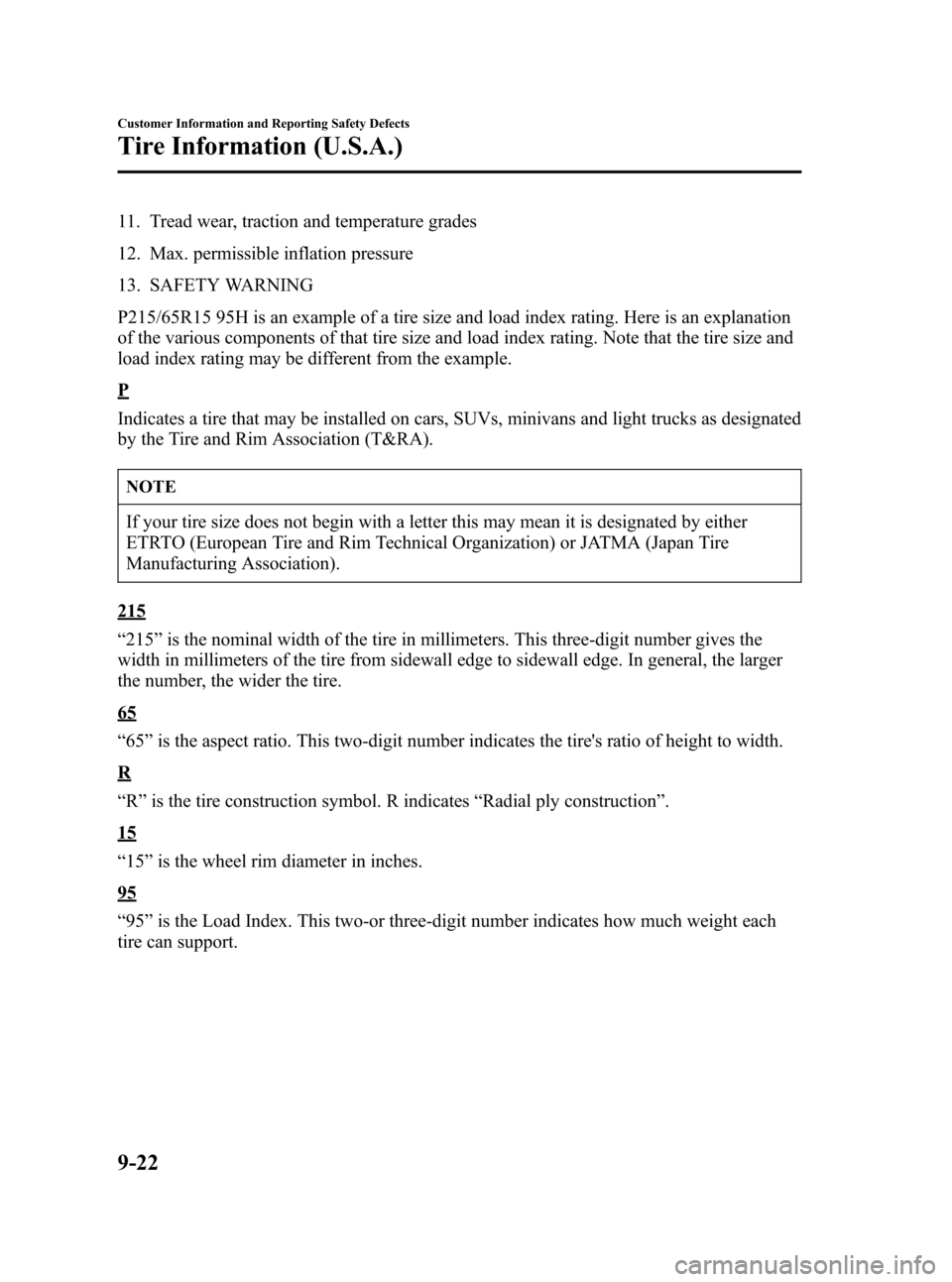
Black plate (336,1)
11. Tread wear, traction and temperature grades
12. Max. permissible inflation pressure
13. SAFETY WARNING
P215/65R15 95H is an example of a tire size and load index rating. Here is an explanation
of the various components of that tire size and load index rating. Note that the tire size and
load index rating may be different from the example.
P
Indicates a tire that may be installed on cars, SUVs, minivans and light trucks as designated
by the Tire and Rim Association (T&RA).
NOTE
If your tire size does not begin with a letter this may mean it is designated by either
ETRTO (European Tire and Rim Technical Organization) or JATMA (Japan Tire
Manufacturing Association).
215
“215”is the nominal width of the tire in millimeters. This three-digit number gives the
width in millimeters of the tire from sidewall edge to sidewall edge. In general, the larger
the number, the wider the tire.
65
“65”is the aspect ratio. This two-digit number indicates the tire's ratio of height to width.
R
“R”is the tire construction symbol. R indicates“Radial ply construction”.
15
“15”is the wheel rim diameter in inches.
95
“95”is the Load Index. This two-or three-digit number indicates how much weight each
tire can support.
9-22
Customer Information and Reporting Safety Defects
Tire Information (U.S.A.)
Mazda3_8U55-EA-05G_Edition2 Page336
Thursday, June 23 2005 2:56 PM
Form No.8U55-EA-05G
Page 337 of 372

Black plate (337,1)
H
“H”is the speed rating. The speed rating denotes the maximum speed for which the use of
the tire is rated.
Letter Rating Speed Rating
Q 99 mph
R 106 mph
S 112 mph
T 118 mph
U 124 mph
H 130 mph
V 149 mph
W 168
*mph
Y 186*mph
* For tires with a maximum speed capability over 149 mph, tire manufacturers sometimes use the letters ZR. For
tires with a maximum speed capability over 186 mph, tire manufacturers always use the letters ZR.
M+S or M/S: Mud and Snow
AT: All Terrain.
AS: All Season. The“M+S”or“M/S”indicates that the tire has some functional use in
mud and snow.
U.S. DOT Tire Identification Number (TIN)
This begins with the letters“DOT”which indicates the tire meets all federal standards. The
next two numbers or letters are the plant code where it was manufactured, and the last four
numbers represent the week and year the tire was manufactured. For example, the numbers
457 means the 45st week of 1997. After 2000 the numbers go to four digits. For example,
the number 2102 means the 21th week of 2002. The other numbers are marketing codes
used at the manufacturer's discretion. This information is used to contact consumers if a tire
defect requires a recall.
Tire Ply Composition and Materials Used
The number of plies indicates the number of layers of rubber-coated fabric in the tire. In
general, the greater the number of plies, the more weight a tire can support. Tire
manufacturers also must indicate the tire materials, which include steel, nylon, polyester,
and other.
Maximum Load Rating
This number indicates the maximum load in kilograms and pounds that can be carried by
the tire.
Maximum Permissible Inflation Pressure
This number is the greatest amount of air pressure that should ever be put in the tire under
normal driving conditions.
Customer Information and Reporting Safety Defects
Tire Information (U.S.A.)
9-23
Mazda3_8U55-EA-05G_Edition2 Page337
Thursday, June 23 2005 2:56 PM
Form No.8U55-EA-05G